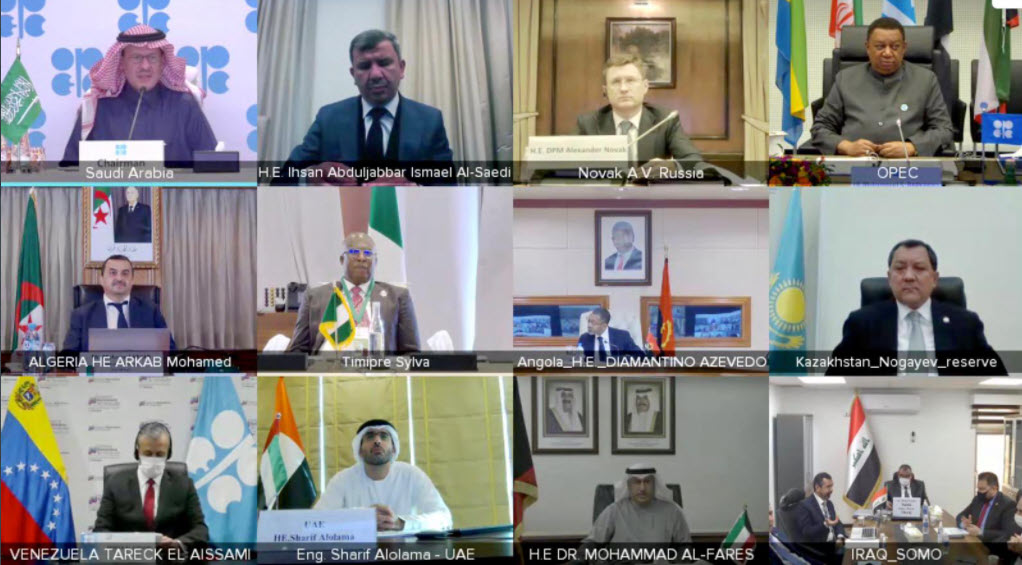A big unilateral cut by Saudi Arabia enabled Opec-plus to post the highest compliance rate so far with the oil production cuts it began implementing last May.
The Saudis lowered their production by 979,000 barrels per day in February — roughly in line with their pledge to make an additional unilateral cut of 1 million b/d — according to Energy Intelligence’s assessment.
That enabled the Opec-plus producer alliance to reach its best-yet compliance rate of 112% for the month.
February was also the first month that Russia — the group’s other heavyweight producer — played by the rules, falling short of its 9.184 million b/d output ceiling by 14,000 b/d and giving it a compliance rate of 101% for the month.
As a result of the unilateral Saudi reduction, Russia produced 1.03 million b/d more than the Saudis in February, even though the two had started implementation of the agreement from an identical base of 11 million b/d and with an equal output cut of 1.88 million b/d.
Opec-Plus Withholds 8 Million b/d
In total, Opec-plus withheld 7.98 million b/d from the market in February, which was 604,000 b/d more than in January, according to calculations by Energy Intelligence, one of six secondary sources that Opec uses to gauge its members’ compliance with supply management pacts.
The additional reduction in output — although largely the result of unilateral action by the Saudis — reinforced the argument that Opec-plus has become the dominant force in global oil markets and should take most of the credit for the strong recovery in oil prices from the depths they sank to in March and April of last year (IOD Mar.8’21).
But the surge in compliance widened the existing dichotomy within the alliance, whereby the Opec members — led by Saudi Arabia — shoulder most of the burden of production cuts compared to the non-Opec members.
Specifically, February compliance for the Opec members amounted to 124%, the highest yet. But the non-Opec contingent mustered only 91%, the lowest since May.
There are 23 countries that are part of the Opec-plus agreement, but only 19 have constraints on their output. Of those, 10 are Opec members. Three other Opec members — Iran, Libya, Venezuela — have no quota — and the same is true of non-Opec Mexico.
Russia Plays by the Rules
Although Russia came in below its output ceiling, Kazakhstan and Oman — the second and third-largest non-Opec producers — saw a surge in output, according to Energy Intelligence calculations. Together they cranked out 191,000 b/d above their targets, accounting for the bulk of the 239,000 b/d that the non-Opec subgroup overproduced for the month.
Kazakhstan started ratcheting up production at its giant Tengiz field by 20% in February to 79,000 metric tons per day, or 625,700 b/d, according to data from the country’s oil ministry. Largely as a result of this, Kazakh output was assessed by Energy Intelligence at 1.55 million b/d, resulting in a compliance rate of 56%.
Oman, meanwhile, produced 68,000 b/d above its ceiling of 732,000 b/d. Independent shipping data and import statistics from Asian countries show that Oman has pursued an assertive export policy in recent months.
Energy Intelligence believes this reflects a concerted effort by Oman to defend market share, particularly in China, and boost revenues to fund large infrastructure projects and meet impending debt payments.
Looking ahead, many analysts feel that Opec-plus will maintain a piecemeal approach to returning barrels to the global market as more people are vaccinated and economies emerge from the pandemic doldrums.
“I think they will add barrels incrementally … I don’t think they’ll dump the barrels on the market all at once. That’ll be the game plan going into the April meeting,” said Robert Yawger, director of energy futures at Mizuho Securities (IOD Mar.4’21).

